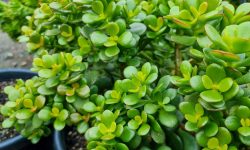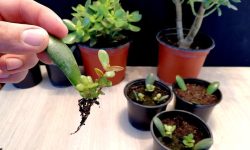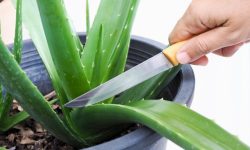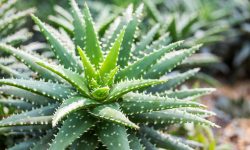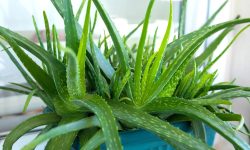Watering a jade plant seems simple at first, but the plant responds to moisture in a very specific way. Its thick leaves act like storage vessels, holding water for long periods and allowing the plant to survive long stretches of dryness. Because of this ability, watering becomes a balancing act rather than a routine schedule. Too much moisture weakens the plant and disrupts its natural rhythm. Too little water slows growth and reduces leaf firmness. Understanding this balance helps you create a watering pattern that matches the jade plant’s slow and steady lifestyle. Proper hydration brings out strong color, thick leaves, and consistent growth.
Knowing how often to water a jade plant requires observing the plant rather than following strict rules. Every jade plant reacts differently depending on light, temperature, pot size, and soil type. When these elements align, the plant absorbs moisture smoothly and develops a stronger root system. When they fall out of balance, the plant shows clear signs of stress that guide your adjustments. Learning these signals makes watering simpler and more predictable. With the right approach, watering becomes a supportive routine that strengthens the plant instead of stressing it. This guide helps you understand how often to water a jade plant the right way for long-term health.
Understanding the Jade Plant’s Natural Hydration Rhythm

Understanding the jade plant’s natural hydration rhythm is the first step toward watering it correctly. Jade plants store water inside their thick leaves, allowing them to survive long periods without moisture. This built-in storage system protects the plant from drought but also makes it sensitive to excess water. The plant depends on slow moisture cycles instead of frequent watering. When the soil fully dries before the next watering, the roots stay strong and firm. Dry cycles help the plant regulate internal pressure and maintain balanced growth. A jade plant thrives when its hydration pattern matches its natural rhythm.
The hydration rhythm also changes with the environment. Warm rooms increase evaporation and encourage the plant to use more water. Cooler rooms slow moisture use and keep the soil wet for longer periods. Light plays a major role because brighter conditions increase the plant’s internal activity. When the jade plant receives steady light, its hydration cycle becomes predictable. In low light, the plant consumes less water and becomes more vulnerable to overwatering. Matching your watering routine to the environment prevents both dehydration and rot.
Seasonal changes further influence the jade plant’s hydration needs. During spring and summer, the plant grows actively and uses water more quickly. Drying times become shorter, and the plant benefits from slightly more frequent waterings. In fall and winter, growth slows, and drying time increases. Overwatering during these months creates dangerous conditions around the roots. Observing seasonal behavior helps you adjust your routine with confidence. When you understand these natural rhythms, your jade plant receives the perfect amount of water at the right time.
Understanding How Soil Type Affects Watering Frequency
Soil type plays a major role in determining how often a jade plant needs water. Jade plants store moisture inside their leaves, so they rely on soil that dries at a steady and predictable pace. Fast-draining soil removes excess moisture quickly, preventing water from sitting around the roots. When soil drains well, the plant experiences natural dry cycles that match its desert-adapted needs. These dry intervals strengthen root fibers and support balanced hydration. Poorly draining soil holds moisture longer than necessary, forcing the plant into stress. Understanding how soil behaves helps you create a proper watering routine.
Different soil mixes hold water at different speeds. A mix with large particles such as perlite, coarse sand, or pumice drains faster and prevents soggy conditions. These components create air pockets that allow roots to breathe freely. When the soil dries quickly, watering becomes less frequent but more controlled. Dense or compact soil behaves differently because it traps moisture and reduces airflow. This slow evaporation increases the chances of rot and weakens the plant’s natural rhythm. Choosing the correct soil type ensures your jade plant receives hydration at a healthy pace. Each soil blend changes how roots absorb moisture.
Monitoring how soil responds after each watering helps refine your long-term routine. If the soil dries within a few days, the plant likely needs more frequent watering during warm seasons. If the soil stays wet for many days, watering must be reduced to avoid stress. Seasonal temperature shifts also change how soil behaves because warm air speeds evaporation while cool air slows drying. Understanding these patterns allows you to adjust your schedule confidently. A soil mix that drains well supports predictable hydration and prevents serious issues. When soil type aligns with the jade plant’s natural needs, watering becomes simple and reliable.
Checking Soil Moisture: Practical Methods
Checking soil moisture correctly is one of the most reliable ways to avoid overwatering or underwatering a jade plant. Jade plants rely on dry cycles to maintain strong roots, so knowing when the soil is ready for water becomes essential. The simplest method is the touch test, where you press your finger into the top layer of soil. If the soil feels dry and loose, the plant is ready for water. If the soil feels cool or slightly damp, it still holds enough moisture. Touching the soil gives immediate feedback and helps you build a consistent watering routine.
Another dependable method is lifting the pot to feel its weight. Dry soil becomes noticeably lighter, while wet soil feels heavy. This method works well for growers who do not want to disturb the soil surface too often. It also helps you understand how long the plant takes to dry between waterings. Monitoring pot weight becomes more accurate over time as you learn how your specific plant behaves. Each pot, soil mix, and environment dries differently, so this method encourages better observation.
Using a moisture meter provides additional accuracy for growers who want more precise readings. A simple meter measures moisture levels deep within the soil, where new roots often sit. This tool helps prevent watering too early, especially when the top soil dries faster than the lower layers. However, moisture meters should be used gently to avoid damaging delicate roots. Combining visual checks with moisture readings creates a complete picture of soil conditions. When you use several practical methods, you gain a clearer understanding of your jade plant’s needs and reduce the chances of watering mistakes. Proper moisture checking supports long-term health and stable hydration patterns.
How Environment and Climate Influence Watering Needs
Environment and climate play major roles in determining how often a jade plant needs water. These succulents come from dry regions where rainfall remains limited and predictable. When the environment stays warm, dry, and bright, the plant absorbs moisture at a steady pace. Higher temperatures increase evaporation and encourage the plant to use stored water more quickly. In these conditions, the soil dries faster and requires more frequent checks. Understanding these environmental signals helps you adjust watering before the plant experiences stress.
Climate also affects how long the soil holds moisture. In humid regions, soil dries slowly, even when temperatures remain warm. A jade plant in humid air needs less water because the environment already slows evaporation. This difference becomes clear when two identical plants in different climates require completely different watering routines. Cold climates slow moisture use even more, forcing the plant to rely on stored water for longer periods. When temperatures drop, the jade plant becomes less active and uses less moisture each day. These changes explain why watering must match climate patterns.
Indoor climate adds another layer of influence. Air conditioning reduces humidity and speeds evaporation, while heated rooms during winter create very dry air. Both conditions cause soil to dry faster, leading to slightly more frequent watering. Rooms with limited airflow slow drying and hold moisture longer, increasing the risk of overwatering. Placing the jade plant near windows changes how quickly it loses water because natural light affects temperature around the pot. Understanding these indoor shifts helps you refine your watering schedule. When environment and climate stay balanced, your jade plant maintains steady hydration and healthy, predictable growth.
Recognizing the Right Time to Water a Jade Plant
Recognizing the right time to water a jade plant begins with watching how the soil behaves. Jade plants rely on dry periods to maintain strong roots, so the soil must always dry completely before each watering. When the soil feels cool, firm, and dusty on the surface, the plant is likely ready for moisture. Deeper dryness also matters because jade roots prefer light soil that drains consistently. Touching the top layer gives a quick indicator, but checking the soil’s overall feel provides a more accurate understanding. When the soil meets both conditions, watering becomes safe and beneficial.
Leaf texture also reveals important clues about hydration needs. Firm leaves indicate a stable moisture balance, while soft or wrinkled leaves suggest the plant needs attention. Jade plants store water inside thick leaves, so changes in texture become early signals. Wrinkling usually appears when the plant has used most of its stored moisture. Soft leaves, however, often point to excess watering or retained moisture within the soil. Reading these signs helps you avoid mistakes and adjust your routine. Observing the leaves weekly builds a reliable habit that keeps the plant healthy.
Environmental conditions influence how quickly a jade plant needs water. Warm rooms, bright indirect light, and active growing seasons increase moisture use. The soil dries faster, so watering occurs more frequently. Cooler months slow evaporation and reduce the plant’s water needs. During this time, the soil may remain dry for much longer. Understanding these seasonal patterns helps you create a flexible watering schedule. Jade plants respond best when watering follows natural conditions rather than fixed routines. Recognizing these signals ensures hydration stays balanced and predictable throughout the year.
Adjusting Watering Frequency Across Different Seasons
Watering frequency must change with the seasons because a jade plant’s hydration needs shift throughout the year. During warm months, sunlight increases and temperatures rise, causing the soil to dry more quickly. The plant becomes more active and uses moisture at a faster rate. This cycle encourages stronger growth and supports new leaves. Watering during this period requires closer observation because dry soil can appear within a few days. Maintaining steady moisture without overwatering helps the plant stay balanced during its most active phase.
In cooler months, the jade plant enters a slower growth pattern and reduces its water use. Soil remains wet for longer periods because evaporation decreases. This slower drying time means the plant needs far less water. Watering too frequently during this season often leads to root stress. Allowing the soil to dry completely becomes essential. The plant’s leaves stay firm when moisture remains balanced, even with less frequent watering. Light also weakens during winter, so the jade plant absorbs less water overall. Adjusting your routine prevents moisture buildup.
Seasonal transitions require careful attention because the plant adapts gradually to temperature changes. During early spring and early fall, soil may dry unevenly as conditions shift. Monitoring the soil becomes even more important during these periods. The jade plant responds well to consistency, so avoid sudden changes in watering habits. Instead, adjust slowly in response to soil moisture and leaf firmness. Seasonal adjustments help the plant maintain stability throughout the year. When watering aligns with natural seasonal rhythms, the jade plant grows with better health, stronger roots, and more predictable hydration.
Recognizing Signs of Overwatering and Underwatering
Recognizing the signs of overwatering helps you protect your jade plant from early stress. Jade plants store moisture inside their thick leaves, so extra water quickly creates soft tissue. When the plant receives too much water, its leaves often turn pale or mushy. Stems may feel swollen or weak, and soil may stay wet for unusually long periods. These changes signal that the roots struggle to breathe. Overwatering limits airflow and encourages rot, which spreads quietly at the base of the plant. Catching these early signs prevents deeper damage and restores hydration balance.
Underwatering produces a different set of signals. When the plant lacks moisture, its leaves begin to wrinkle as stored water decreases. The plant may look dull, and leaf edges may fold inward. The soil becomes very dry and separates slightly from the pot’s edges. These symptoms show that the plant needs steady hydration, not frequent watering. A single deep watering usually restores firmness in a short time. Jade plants respond well to this cycle because it mirrors their natural environment. Recognizing this pattern helps you adjust watering schedules with confidence.
Balanced hydration means watching for subtle changes between these two extremes. A healthy jade plant has firm leaves, bright color, and soil that dries at a predictable pace. Monitoring leaf texture gives you reliable feedback about moisture levels inside the plant. Observing the soil gives you information about root conditions. When both stay consistent, your watering routine matches the plant’s natural rhythm. This balance allows the plant to grow slowly but steadily. Understanding these signals creates a confident approach to watering that supports long-term health and stable development.
Preventing Common Watering Mistakes
Overwatering and Its Hidden Consequences
Overwatering remains the most damaging mistake for jade plants because their roots cannot tolerate prolonged moisture. Many growers assume consistent watering supports growth, but jade plants store water within their leaves and stems. When soil stays wet for too long, oxygen levels around the roots decrease. This lack of airflow allows rot-causing organisms to spread. Symptoms like soft leaves, dark spots, or mushy stems appear gradually. These signs often show internal damage that formed days earlier. Learning how moisture behaves in your soil prevents this silent progression. Jade plants thrive when allowed to dry thoroughly between each watering cycle.
Preventing overwatering requires understanding how slowly jade roots absorb moisture. Light watering works better than large amounts because it protects the root system from saturation. Choosing well-draining soil reduces the risk of trapped water, while pots with large drainage holes improve moisture escape. Observing the soil surface provides reliable clues about hydration levels. If the soil feels cool or compact, it may still contain hidden moisture. Letting it dry completely restores balance and protects fragile roots. When moisture remains controlled, jade plants maintain firm leaves, steady color, and stable long-term growth.
Underwatering and Slow Dehydration Stress
Underwatering occurs more slowly than overwatering but can still weaken a jade plant. When moisture remains too low for extended periods, leaves begin to wrinkle as stored water depletes. The plant reacts by slowing its metabolic activity to conserve resources. This reduced activity limits new growth and weakens stems. In severe cases, the plant drops lower leaves to preserve water in upper sections. These symptoms often appear after long gaps in watering or when soil dries faster than expected. Jade plants tolerate dryness well, but regular extreme dehydration disrupts their natural rhythm.
Preventing underwatering involves establishing a consistent watering routine based on soil dryness rather than fixed schedules. Touching the soil helps determine when hydration is necessary. If the soil feels dusty, brittle, or pulls away from the pot edges, the plant may need water. Gradual watering works best because dry soil absorbs moisture unevenly at first. Increasing humidity slightly around the plant can help reduce water loss during hot months. Once hydration stabilizes, leaves regain firmness and metabolic activity increases. Balanced watering encourages steady growth and prevents dehydration stress from weakening the root system.
Watering Too Quickly After Repotting
Watering too quickly after repotting is a common mistake because jade plants experience root sensitivity during transitions. Freshly disturbed roots require time to settle into new soil before absorbing moisture. When watered immediately, the soil may become compacted, reducing airflow around healing roots. Excess moisture also increases the risk of rot because roots remain vulnerable after pruning or repositioning. Dry soil gives the root system time to adapt and create fine root hairs that improve moisture absorption. Allowing this brief pause helps the plant stabilize and reduces transplant shock.
Proper post-repotting care involves letting the soil rest for several days before the first watering. This pause ensures the callused roots adjust safely to their environment. Bright indirect light supports recovery by encouraging light metabolic activity without overheating the plant. Checking soil texture helps determine optimal timing. If the soil feels loose and airy, it remains safe to water lightly. Controlled hydration encourages roots to grow outward and anchor the plant. Avoid fertilizing during this period because nutrients can irritate stressed roots. When repotting aftercare stays stable, jade plants resume strong growth with improved hydration efficiency.
Best Watering Practices for Indoor vs Outdoor Jade Plants
Watering indoor jade plants requires careful attention because indoor environments usually dry more slowly and receive less natural airflow. Indoor jade plants rely on controlled moisture cycles to maintain firm leaves and compact growth. Allow the soil to dry completely before watering again, since indoor conditions often keep moisture trapped near the roots. Bright indirect light helps balance hydration by supporting steady internal activity. Avoid watering based on a fixed schedule because room temperature, humidity, and light exposure change throughout the year. Indoor jade plants thrive when watering adapts to seasonal and environmental shifts.
Outdoor jade plants experience stronger light, wider temperature swings, and faster soil evaporation. These factors increase their water needs during warm months. When grown outdoors, the plant receives more direct sunlight, which speeds hydration loss and stimulates more active growth. Outdoor soil also dries faster, requiring slightly more frequent watering. However, water should still be applied only when the soil turns completely dry. Overwatering outdoors occurs when containers lack proper drainage or when rain adds extra moisture. Observing soil texture and leaf firmness helps you adjust watering confidently.
Because indoor and outdoor conditions differ greatly, each environment demands a distinct approach. Indoor plants need slower hydration patterns, while outdoor plants require closer monitoring during hot or windy weather. Moving jade plants between environments also affects watering needs. A newly relocated plant may experience brief stress and require lighter watering until it adapts. Understanding these differences helps prevent rot, dehydration, and uneven growth. When watering routines match environmental conditions, jade plants remain strong, balanced, and better prepared for long-term development.
FAQs About How Often to Water Jade Plant
How do I know when my jade plant needs water?
You can check the soil dryness with your fingers. Dry soil signals the right moment to water. Firm leaves also show stable hydration. Wrinkled leaves indicate mild thirst. Observing both soil and leaves provides the clearest guide.
What happens if I water my jade plant too often?
Overwatering leads to soft leaves, weak roots, and possible rot. Soil that stays wet disrupts oxygen flow. The plant loses firmness and begins to decline. Allowing soil to dry fully between waterings protects long-term health and restores stability.
Why does my jade plant dry out faster in some months?
Seasonal changes alter evaporation and growth speed. Warm months increase growth and moisture use. Cool months slow these processes. Light, temperature, and airflow also influence drying. Adjusting watering frequency each season keeps hydration balanced.
Can I use a moisture meter for jade plants?
Yes, a moisture meter helps detect deeper soil moisture. It prevents overwatering by showing hidden wet zones. Use the meter gently to avoid damaging roots. Combine meter readings with leaf observation for the most accurate watering routine.
How long can a jade plant go without water?
A healthy jade plant can survive weeks without water due to stored moisture. Warm conditions shorten this period. Cooler rooms extend dryness tolerance. Watch for slight wrinkling as a natural indicator. Water when the soil becomes completely dry.
Final Thoughts
Watering a jade plant correctly becomes much easier once you understand how its natural rhythm shapes each response. These succulents thrive with slow, controlled hydration, so every watering choice influences their long-term strength. When soil, light, and climate remain steady, the plant maintains firm leaves, stable growth, and clear color. Small adjustments in watering frequency make a noticeable difference, especially as seasons change and the plant adapts. With patience, observation, and a balanced routine, your jade plant develops deeper roots and a healthier structure. Caring for a jade plant becomes simple when you trust its signals and allow it to grow at its natural pace. A well-watered jade plant stays resilient, attractive, and ready to thrive for many years.


